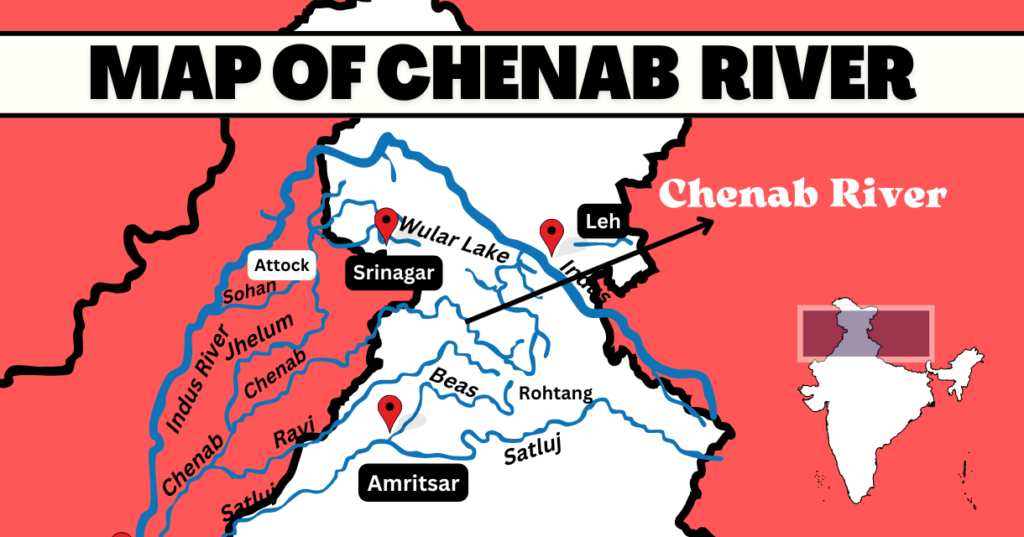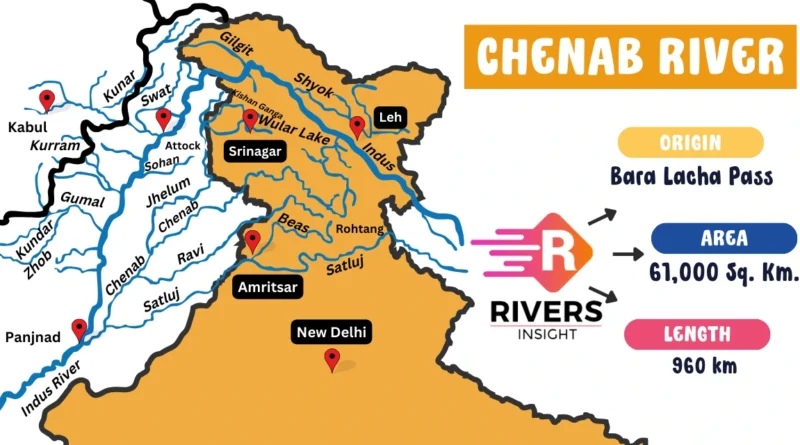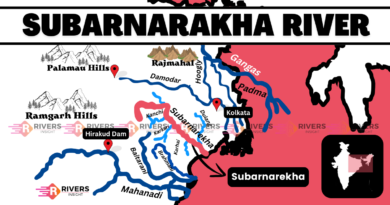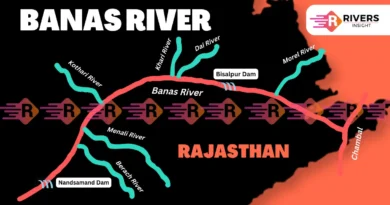Chenab River: Origin & Length with Map
The Chenab River is a major tributary of the Indus River system, flowing through the northern region of India and into Pakistan. Its catchment area is around 61000 sq. km. It is formed by the confluence of the Chandra and Bhaga rivers at Tandi in the upper Himalayas, in the Lahaul and Spiti District of Himachal Pradesh, India.
| River | Chenab |
| Origin | Bara Lacha Pass |
| Length | 960 km |
| Tributary of | Indus River |
| Tributaries | Miyar Nalla, Marusudar, and Lidrari |
Table of Contents
Chenab River
The Chenab River, literally meaning “Moon River” in Urdu and Punjabi, is a major river that flows through India and Pakistan. It is one of the five major rivers of Punjab, collectively known as the “Panj Nad,” alongside the Satlej, Beas, Ravi, and Jhelum rivers.
Origin of Chenab
Chenab River originates from the Bara Lacha Pass in Himachal at an elevation of about 4,000 meters. It flows through the state of Jammu and Kashmir before entering Pakistan, becoming a key tributary of the Indus River system.
Length & Course
The Chenab River, with a length of approximately 960 kilometers, begins as the Chandrabhaga after the confluence of the Chandra and Bhaga rivers at Tandi in Himachal Pradesh. It flows through the rugged terrain of the Pir Panjal mountain range in Jammu and Kashmir.
After crossing into the Jammu region, it becomes the Chenab when it joins the Marau River at Bhandera Kot. From there, it flows in a southeastern direction, passing through a series of valleys and plains. The river continues its journey through the plains of Punjab, entering Pakistan, and eventually merges with the Indus River near the town of Mithankot.
Important locations along the course of the Chenab River include:
- Tandi (Confluence of the Chandra and Bhaga rivers)
- Bhandera Kot (Confluence with the Marau River)
- Jammu (Flowing through the city)
- Akhnoor (A significant town along the river)
- Trimmu (Confluence with the Jhelum and Ravi rivers)
- Uch Sharif (Confluence with the Sutlej River)
- Mithankot (Where the Chenab merges with the Indus River)
Map of Chenab River

Tributaries
- Marusudar: Largest tributary, joining Chenab at Bhandarkot, nourishing agricultural lands.
- Miyar Nalla: Himalayan source, contributing to Chenab’s cool character.
- Liddari: Scenic valleys, enriching biodiversity and charm.
- Tawi: Cultural significance near Jammu, providing irrigation and holding a place in local rituals.
- Kalnai & Neeru: Key tributaries in Pakistan, play vital roles in irrigation and agriculture.
Dams on the Chenab River
Here’s a list of some notable dams on the Chenab:
In India:
- Salal Dam: This 690 MW behemoth near Reasi, Jammu and Kashmir, is a marvel of engineering, generating clean energy and regulating river flow.
- Baglihar Dam: Standing tall near Ramban, Jammu and Kashmir, this 900 MW dam is another major source of hydropower for India.
- Dul Hasti Hydroelectric Plant: Located in Kishtwar District, Jammu and Kashmir, this 390 MW plant harnesses Chenab’s power for electricity generation.
- Ratle Hydroelectric Plant: Currently under construction near Drabshalla in Kishtwar District, this project aims to add 850 MW to India’s power grid.
- Pakal Dul Dam: A controversial project on the Marusudar tributary, this dam has caused friction between India and Pakistan due to concerns about its impact on downstream water availability. Construction is ongoing despite opposition.
In Pakistan:
- Marala Headworks: Located near Sialkot and Gujrat District, this headworks diverts water from the Chenab for irrigation purposes in Pakistan.
- Khanki Headworks: Situated in Gujranwala District, this headworks also plays a crucial role in irrigating Pakistan’s agricultural lands.
- Qadirabad Headworks: Found in Mandi Bahauddin District, this headworks further contributes to Pakistan’s irrigation network.
- Trimmu Barrage: Located in Jhang District, this barrage helps regulate the flow of the Chenab for irrigation and hydropower generation.
These dams, along with others in the planning or construction stages, have undoubtedly altered the Chenab’s landscape and its impact on the surrounding communities.
Modern Developments
The Chenab River is currently at the center of various modern changes, bringing both potential benefits and sparking controversies and environmental worries. Let’s take a closer look at some important topics:
- Hydropower: A Balancing Act: India’s hydropower projects like the Baglihar Dam offer clean energy and water regulation, but face opposition from Pakistan over downstream impacts and ecological disruption. Balancing energy needs with environmental protection remains a crucial challenge.
- Chenab Bridge: An Engineering Marvel on the Horizon: The construction of the world’s highest railway bridge, a 1,315-meter behemoth, promises to boost connectivity and trade. However, its massive scale and potential environmental footprint necessitate responsible practices and long-term monitoring.
- Navigating Shared Waters: The Indus Waters Treaty of 1960 treaty allocates water rights between India and Pakistan, including the Chenab. While it has prevented major water disputes, its interpretation and implementation remain contentious. Finding common ground and fostering cooperation on water management are crucial for the Chenab’s future.
- Beyond Dams: Protecting a Shared Resource: Pollution, climate change, and unsustainable resource extraction threaten the Chenab’s health and ability to sustain communities. India and Pakistan must invest in pollution control, adopt sustainable practices, and implement comprehensive water management strategies to protect the river.
Cultural Significance
- Vedic Origins: In the ancient Vedic period, the Chenab, known as Ashkini or Iskmati, was considered a sacred river, intertwined with myths and religious practices. People believed it possessed divine qualities, bringing life and prosperity. This reverence is evident in hymns and rituals, solidifying its place in religious traditions.
- Punjabi Legacy: Over time, the Chenab became deeply embedded in Punjabi culture. Its waters witnessed the evolution of traditions and rituals, often associated with fertility, purification, and spiritual renewal. Festivals like Lohri and Baisakhi draw upon the river’s symbolism, and its vibrant flow inspires countless folk songs and dances.
Today, the Chenab confronts new challenges—pollution, climate change, and escalating water demands. Addressing these issues necessitates collective action, involving not only the governments of India and Pakistan but also the communities reliant on the river. Together, we can ensure the Chenab continues to flow—a symbol of hope and resilience—for generations to come.
The Chenab River is more than a geographical feature; it’s a living entity that ties together the people, history, and culture of the Punjab region. Standing on its banks, we’re reminded of the intricate web of life it sustains. It’s our shared responsibility to protect it for the well-being of future generations.
Thank You!
FAQs
Where does the Chenab River originate?
The Chenab River starts where the Chandra and Bhaga rivers meet at Tandi in the Lahaul and Spiti districts of Himachal Pradesh, India.
Chenab River originates from which glacier?
The Chenab River originates from the Bara Lacha Glacier in the Himalayas.
What is the total length of the Chenab?
The total length of the Chenab River is approximately 960 kilometers (about 600 miles).




